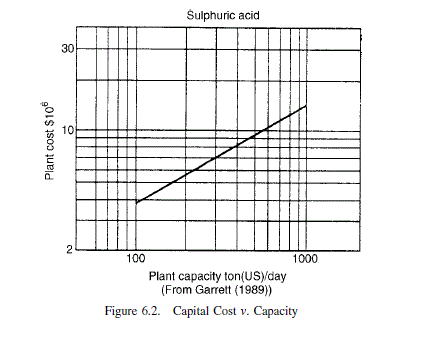Obtain a rough estimate of the cost of a plant to produce 750 tonnes per day of sulphuric acid, from sulphur. Use the costs given by Garrett (1989) reproduced in Figure 6.2.
Question 6.2: Obtain a rough estimate of the cost of a plant to produce 75...

The Blue Check Mark means that this solution has been answered and checked by an expert. This guarantees that the final answer is accurate.
Learn more on how we answer questions.
Learn more on how we answer questions.
Garret’s units are US dollars and US tons, and refer to 1987 (Chemical Engineering Index quoted as 320).
1 US ton = 2000 lb = 0.91 tonne (1000 kg)
So, 750 tonne per day = 750/0.91 = 824 US t/d
From Figure 6.2 the fixed capital cost for this capacity, for production from sulphur, is 13 \times 10^{6} US dollars.
There are two possible ways to convert to UK costs:
1. Convert at the 1987 exchange rate and update using a UK index.
2. Update using a US index and convert using the current exchange rate.
1. In 1987 (January) the rate of exchange was $1.64 = £1, and UK and US cost can be taken as roughly equivalent.
1987 cost =\frac{13 \times 10^{6}}{1.64}=£ 7.93 \times 10^{6}
Updating this cost using the index published in Process Engineering (basis 100 at end 1990)
Index 1987 (January) = 78
2004 (January) = 154 (basis adjusted to 1990)
\text { So, capital cost of plant early } 2004=7.93 \times 10^{6} \times \frac{154}{78}=£ 15.67 \times 10^{6}
\text { say, } £ 16,000,000
2. Garrett quotes the Chemical Engineering Index for his costs as 320 (January 1987).
The value in January 2004 was, approximately, 405, so the dollar cost of the plant in early 2004 will be:
13 \times 10^{6} \times \frac{405}{320}=\$ 16.45 \times 10^{6}
The rate of exchange in January 2004 was $1.82, so the cost in pounds sterling will be
\frac{16.45 \times 10^{6}}{1.82}=£ 9.04 \times 10^{6}
say, $9,000,000
Widely different from that estimated by method 1. This is not surprising as inflation in the UK has been very much greater than that in the US over this period.
Where UK, or other local, indexes and historical exchange rates are available, it is probably better to convert costs to the local currency using the rate of exchange ruling at the date of the costs and update using the local index: method 1 in the Example 6.2. In the United Kingdom historical values for exchange rates can be found in the government publication Economic Trends (Central Statistical Office, HMSO). Current and historical values for most currencies can be found on the Internet/World Wide Web.
As a rough guide US costs can be taken as equivalent to local prices, converted to local currency, for Western European countries, but construction costs may be significantly greater in less developed parts of the world.
Location factors can be used to make allowance for the variation in costs in different countries; see IChemE (1987).
Related Answered Questions
Purchased cost of major equipment items.
Absorptio...
There are two ways of looking at the earnings to b...
The cash-flow calculations are summarised in Table...
Number of significant processing steps 6.
Capacity...